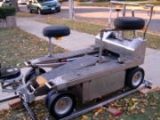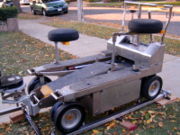
Camera dolly
Encyclopedia

Filmmaking
Filmmaking is the process of making a film, from an initial story, idea, or commission, through scriptwriting, casting, shooting, directing, editing, and screening the finished product before an audience that may result in a theatrical release or television program...
and television production equipment designed to create smooth camera movements (cinematic techniques
Cinematic techniques
- Basic Definitions of Terms :Aerial Shot:A shot taken from a crane, plane, or helicopter. Not necessarily a moving shot.Backlighting:The main source of light is behind the subject, silhouetting it, and directed toward the camera....
). The camera is mounted to the dolly and the camera operator
Camera operator
A camera operator or cameraman is a professional operator of a film or video camera. In filmmaking, the leading cameraman is usually called a cinematographer, while a cameraman in a video production may be known as a television camera operator, video camera operator, or videographer, depending on...
and focus puller
Focus puller
A focus puller, or 1st assistant cameraman, is a member of a film crew’s camera department whose primary responsibility is to maintain image sharpness on whatever subject or action is being filmed....
or camera assistant, usually ride on the dolly to operate the camera. The dolly grip
Dolly grip
In cinematography, the dolly grip dedicated technician trained to operate the camera dolly. The individual places, levels, and moves the dolly track, then pushes and pulls the dolly and usually a camera operator and camera assistant as riders. If the dolly has a moveable vertical axis, such as a...
is the dedicated technician trained to operate the dolly.
Movement
The camera dolly may be used as a shooting platform on any surface but is often raised onto a track, to create smooth movement on a horizontal axis known as a dolly shot. Additionally, most professional film studio dollies have a hydraulic arm that raises or lowers the camera on the vertical axis. When a dolly gripDolly grip
In cinematography, the dolly grip dedicated technician trained to operate the camera dolly. The individual places, levels, and moves the dolly track, then pushes and pulls the dolly and usually a camera operator and camera assistant as riders. If the dolly has a moveable vertical axis, such as a...
operates a dolly on perpendicular axes simultaneously, it's known as a compound move.
Dolly moves may also be executed without track, giving more freedom on the horizontal plane and with it, a higher degree of difficulty. These are called dancefloor moves and may either be done on the existing surface (if smooth enough) or on an overlay designed for dolly movement. The ground overlay usually consists of thick plywood
Plywood
Plywood is a type of manufactured timber made from thin sheets of wood veneer. It is one of the most widely used wood products. It is flexible, inexpensive, workable, re-usable, and can usually be locally manufactured...
as a bottom layer and masonite
Masonite
Masonite is a type of hardboard invented by William H. Mason.-History:Masonite was invented in 1924 in Laurel, Mississippi, by William H. Mason. Mass production started in 1929. In the 1930s and 1940s Masonite was used for many applications including doors, roofing, walls, desktops, and canoes...
on top.
Camera dollies have several steering mechanisms available to the dolly grip. The typical mode is rear-wheel steering, where the front wheels remain fixed, while the wheels closest to the operating handle are used to turn. A second mode, round steering, causes the front wheels to turn in the opposite direction from the rear wheels. This mode allows the dolly to move in smooth circles and is frequently used when the dolly is on curved track. A third mode, called crab steering, where the front wheels turn in the same direction as the rear wheels. This allows the dolly to move in a direction diagonal to the front end of the dolly.
Types
Studio dollies are large, stable and can feature hydraulics. These are the first choice for studio, backlot and location shoots when using professional cameras. A studio dolly usually needs a specialized operator called a "dolly grip".Lightweight dolly systems are simpler, more affordable and are best used with lighter-weight cameras. Lightweight systems are usually favored by independent filmmakers and students because they are easier to operate. There are riding dollys and also dollys that support only the camera, so that the operator needs to walk alongside. Any dolly that is compact in size when set on floor wheels is called a "doorway dolly."
The best way to be able to replicate the same camera movement for multiple takes (which is important for editing) is to use a dolly on track.
Track
Dolly tracks used for heavy cameras have traditionally been constructed of steelSteel
Steel is an alloy that consists mostly of iron and has a carbon content between 0.2% and 2.1% by weight, depending on the grade. Carbon is the most common alloying material for iron, but various other alloying elements are used, such as manganese, chromium, vanadium, and tungsten...
or aluminium
Aluminium
Aluminium or aluminum is a silvery white member of the boron group of chemical elements. It has the symbol Al, and its atomic number is 13. It is not soluble in water under normal circumstances....
. Steel, although heavier than aluminum, is less expensive and withstands heavier use. Longer track segments, while heavier to transport, allow track to be laid straighter with less effort. Curved track is also available. Plastic versions of track have been used with lightweight dolly systems. In the 2000s, flexible rubber track allowed quicker set up and easier transportation for use with light cameras.

